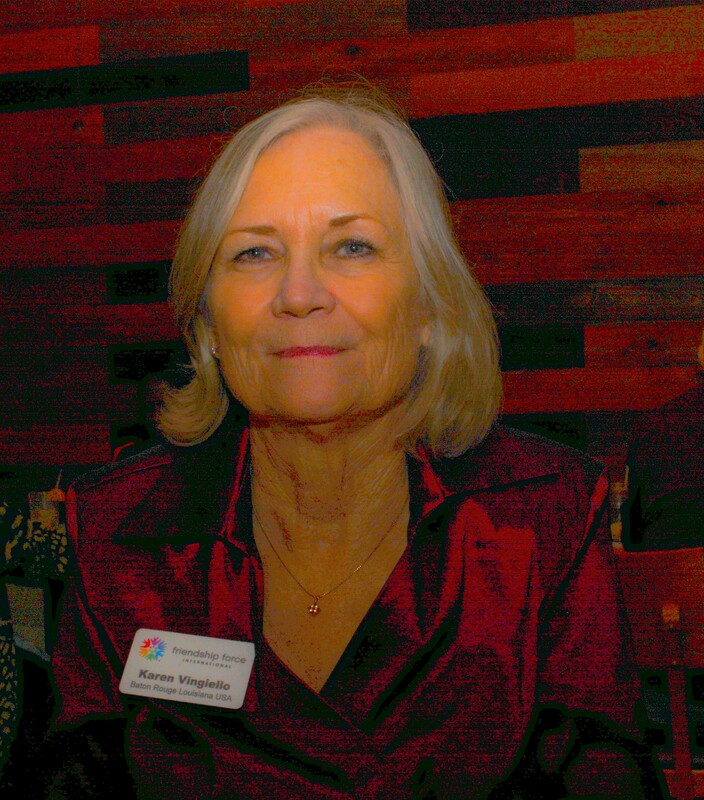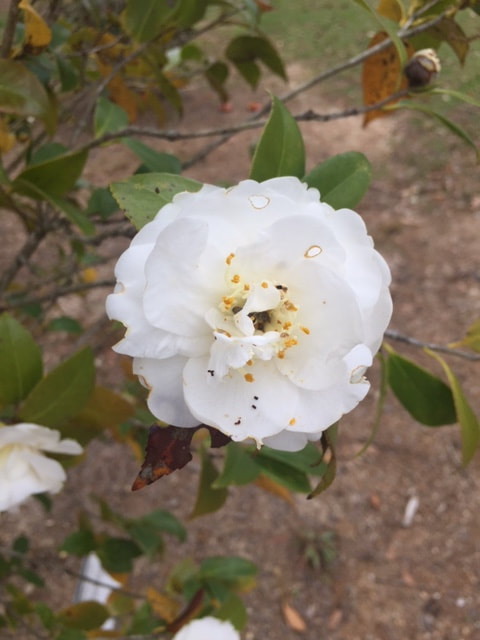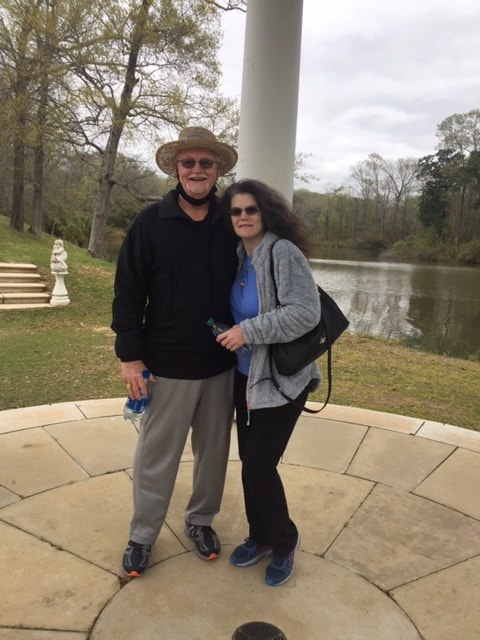Christmas Party and Installation of 2022 President Larry Jonas
Barbara Wittkopf arranged for us to celebrate the end of the year at Cafe American. About 28 members enjoyed a three course sit-down dinner, exchanged Christmas gifts, installed officers, and sang carols. Everyone helped: Bob Duncan blessed the food, Secretary LaDeta Crawley took notes during the meeting and gave everyone a ticket when they brought their gift in, treasurer Lynn Robbins collected dues for 2022, Board Member Mike Wyble set up the bridge of flags, Isabell Zoch (Erwin's grand-daughter) drew numbers for the gift opening, 2021 President Trudy Ivy installed 2022 President Larry Jonas, Larry introduced the 2022 officers, and Board Member Sheila Melancon led us in singing Christmas carols. We ended the evening by singing "Let There Be Peace On Earth."
World Friendship Day and Second Quarterly Meeting
Spring Picnic and Quarterly Meeting
May 1, 2021 at the Vingiello's
Like most Friendship Force clubs around the world, the Baton Rouge club has struggled this past year, but with the help of an energetic board, enthusiastic committees, Zoom, and members who value friendship and the FFI mission we have survived and maybe even come out stronger. That’s why our first meeting (and party) on May 1 was such a celebration. Over 40 members and guests gathered at the home of Karen and Art Vingiello for a picnic supper prepared by the Duncan's, a rowdy game of bocce ball (croquet and cornhole) and our first general membership meeting in over a year.
Club president, Trudy Ivy conducted a survey that showed that members are ready for an incoming journey from Birmingham and outgoing journey to Austin. The survey also included the important policy issue of requiring ambassadors to be vaccinated prior to participating in journeys. A special thank you to our hosts, committee members, and The Estate Center in Hammond for their donation of “beverages” and door prizes.
The Board will be meeting monthly to plan activities for the remainder of the year. We are looking forward to more reasons to celebrate our diversity, our community and our friendships around the world.
Club president, Trudy Ivy conducted a survey that showed that members are ready for an incoming journey from Birmingham and outgoing journey to Austin. The survey also included the important policy issue of requiring ambassadors to be vaccinated prior to participating in journeys. A special thank you to our hosts, committee members, and The Estate Center in Hammond for their donation of “beverages” and door prizes.
The Board will be meeting monthly to plan activities for the remainder of the year. We are looking forward to more reasons to celebrate our diversity, our community and our friendships around the world.
FFBR Members Visit Insta-Gator Hatchery in Covington
April 22, 2021
Fifteen FFBR members* went to Covington April 22 to tour the Insta-Gator Hatchery. Alex served as our guide and described how these American alligators are collected, fed, cared for, and either released, sold, or preserved at the Hatchery.
In the 1950’s there were only an estimated 150,000 alligators in Louisiana. By the 1980’s there was concern about the possible extinction of the alligators and the Louisiana Department of Wildlife and Fisheries created the Alligator Ranching program with a primary goal of preserving the species.
Beginning in October, alligators bury themselves deep in the mud in the marshes to protect themselves from the cold. They do not eat until Spring. In April and May the alligators begin their mating rituals with their bellowing calls to attract suitable mates. In June or July after they mate the females begin to build nests along the banks of the marsh where they will eventually lay up to 60 eggs. Only about 35 remain in the ‘clutch.’ Hatchery staff fly over the breeding grounds and map them for later retrieval. The mothers check on their eggs about every other day. While she’s away, staff, like Alex, retrieve the eggs and bring them to the Hatchery. They are fed food pellets and placed in a secure, climate-controlled environment, where the temperature averages 89 degrees to produce females and 92% to produce males. Alligators in the wild only have a 6-8% survival rate. Females may grow to 9 feet and males to 13 feet. They can live to 70 years. Alligators are cold blooded which is why they are often seen basking in the sun. Vibration sensors on their skin help them locate food sources and they can react quickly in water and on land.
By law, once the gators are 4 feet long (at approximately 8 months) 10% of them must be returned to the marsh. At that time they are not prone to predators except from larger alligators. Alligators not returned to their natural habitat are primarily used for commercial purposes: their skin is used to create products such as watch bands, handbags, shoes, belts, etc. and also sold for their meat. The proceeds are used to support the Industry as there is no federal monies for this project. At the time of our visit Insta-Gator has more than 2,000 gators on site.
The group had an opportunity to see alligators up close, touch and feed them. They could also see a live gator’s ears, nostrils, third eyelid and watch it walk on the grass. One gator is being preserved, for example, because it has no tail, which is necessary for gators to protect themselves in the wild.
Louisiana has more alligators than all the other countries in the world combined and as a result is considered the Alligator capital of the world. Louisiana does not have native crocodiles or caiman as they are called in South America.
After the tour the group drove to downtown Covington for lunch at New Orleans Food and Spirits. [No alligator on the menu.] While waiting to be seated half the group had an opportunity give a friendship send off to Abby, decked in her pink helmet and sunglasses, seated on a Harley Davidson with her parents, Karen and “D” (David), visiting from Denham Springs. After lunch there was an opportunity for all the members to visit various antique and gift shops on Lee Lane before returning home.
Thornton and Barbara, daytrip coordinators.
*Lin Ashton, Kat Battaglia, Thornton Cofield, Keith Corkern, LaDeta Crawley, Jiji and Larry Jonas, Chris Pomfret, Vera Ricard, Alma Thornton, Art and Karen Vingiello, George Ware, Barbara Wittkopf, and Erwin Zoch.
In the 1950’s there were only an estimated 150,000 alligators in Louisiana. By the 1980’s there was concern about the possible extinction of the alligators and the Louisiana Department of Wildlife and Fisheries created the Alligator Ranching program with a primary goal of preserving the species.
Beginning in October, alligators bury themselves deep in the mud in the marshes to protect themselves from the cold. They do not eat until Spring. In April and May the alligators begin their mating rituals with their bellowing calls to attract suitable mates. In June or July after they mate the females begin to build nests along the banks of the marsh where they will eventually lay up to 60 eggs. Only about 35 remain in the ‘clutch.’ Hatchery staff fly over the breeding grounds and map them for later retrieval. The mothers check on their eggs about every other day. While she’s away, staff, like Alex, retrieve the eggs and bring them to the Hatchery. They are fed food pellets and placed in a secure, climate-controlled environment, where the temperature averages 89 degrees to produce females and 92% to produce males. Alligators in the wild only have a 6-8% survival rate. Females may grow to 9 feet and males to 13 feet. They can live to 70 years. Alligators are cold blooded which is why they are often seen basking in the sun. Vibration sensors on their skin help them locate food sources and they can react quickly in water and on land.
By law, once the gators are 4 feet long (at approximately 8 months) 10% of them must be returned to the marsh. At that time they are not prone to predators except from larger alligators. Alligators not returned to their natural habitat are primarily used for commercial purposes: their skin is used to create products such as watch bands, handbags, shoes, belts, etc. and also sold for their meat. The proceeds are used to support the Industry as there is no federal monies for this project. At the time of our visit Insta-Gator has more than 2,000 gators on site.
The group had an opportunity to see alligators up close, touch and feed them. They could also see a live gator’s ears, nostrils, third eyelid and watch it walk on the grass. One gator is being preserved, for example, because it has no tail, which is necessary for gators to protect themselves in the wild.
Louisiana has more alligators than all the other countries in the world combined and as a result is considered the Alligator capital of the world. Louisiana does not have native crocodiles or caiman as they are called in South America.
After the tour the group drove to downtown Covington for lunch at New Orleans Food and Spirits. [No alligator on the menu.] While waiting to be seated half the group had an opportunity give a friendship send off to Abby, decked in her pink helmet and sunglasses, seated on a Harley Davidson with her parents, Karen and “D” (David), visiting from Denham Springs. After lunch there was an opportunity for all the members to visit various antique and gift shops on Lee Lane before returning home.
Thornton and Barbara, daytrip coordinators.
*Lin Ashton, Kat Battaglia, Thornton Cofield, Keith Corkern, LaDeta Crawley, Jiji and Larry Jonas, Chris Pomfret, Vera Ricard, Alma Thornton, Art and Karen Vingiello, George Ware, Barbara Wittkopf, and Erwin Zoch.
Hemingbough and The Francis in St. Francisville
March 19, 2021
Springtime in South Louisiana is bursting with all shades of azaleas, spring green budding trees and birdsong. On March 19th, 2021, 24 members and guests of Friendship Force of Baton Rouge traveled north about 45 minutes to visit Hemingbough Plantation - Convention Center and Gardens to see the magnificent grounds.
Among the guests were Dr. Pamela Ravare-Jones, Assistant Chief Administrative Officer of EBR Parish, who heads the International Relations Commission, along with her assistant, Simone Pillette. They explained the role of the Commission and how it works to enhance relations with other countries. Dr. Jones has quite an extensive background in international relations through living around the world as well as being head of the Association of Latino Professionals for America. Barbara Wittkopf and Thornton Cofield are FFBR’s representatives to the Commission, as well as JiJi Jonas who represents another organization on the Commission, so we are thrilled to have such a wonderful resource in our local government.
The owner of Hemingbough, Arlen Dease, enhanced the rolling landscape with many architectural features, such as statuary, an amphitheater, gardens and water vistas to enjoy while one strolls the surrounding grounds. A small chapel, dedicated to Mr. Dease’s father, greets visitors near the entrance.
Landscape architect Walter Imahara collaborated with Hemingbough in 2018 to create an inspirational, traditional Japanese sanctuary garden for contemplation and appreciation of simplicity of style and nature. It incorporates the many meaningful features of a traditional Japanese garden.
Within the Japanese garden is an Imahara family monument from Hiroshima, Japan, that the family acquired which describes the Imahara family name and is very special to them. For reasons unknown, the statue was spared during the bombing and is in excellent condition. The family, who had originated in Japan but lived in the US during the time of the internment camps during WWII, were very happy to receive it.
After our walk around Hemingbough, many of the group traveled into St. Francisville for lunch at The Francis Southern Table and Bar where we enjoyed a delicious meal and warm southern hospitality. It was a very enjoyable outing for our club, and we are hopeful that it is the first of many after a long year of staying distant.
Among the guests were Dr. Pamela Ravare-Jones, Assistant Chief Administrative Officer of EBR Parish, who heads the International Relations Commission, along with her assistant, Simone Pillette. They explained the role of the Commission and how it works to enhance relations with other countries. Dr. Jones has quite an extensive background in international relations through living around the world as well as being head of the Association of Latino Professionals for America. Barbara Wittkopf and Thornton Cofield are FFBR’s representatives to the Commission, as well as JiJi Jonas who represents another organization on the Commission, so we are thrilled to have such a wonderful resource in our local government.
The owner of Hemingbough, Arlen Dease, enhanced the rolling landscape with many architectural features, such as statuary, an amphitheater, gardens and water vistas to enjoy while one strolls the surrounding grounds. A small chapel, dedicated to Mr. Dease’s father, greets visitors near the entrance.
Landscape architect Walter Imahara collaborated with Hemingbough in 2018 to create an inspirational, traditional Japanese sanctuary garden for contemplation and appreciation of simplicity of style and nature. It incorporates the many meaningful features of a traditional Japanese garden.
Within the Japanese garden is an Imahara family monument from Hiroshima, Japan, that the family acquired which describes the Imahara family name and is very special to them. For reasons unknown, the statue was spared during the bombing and is in excellent condition. The family, who had originated in Japan but lived in the US during the time of the internment camps during WWII, were very happy to receive it.
After our walk around Hemingbough, many of the group traveled into St. Francisville for lunch at The Francis Southern Table and Bar where we enjoyed a delicious meal and warm southern hospitality. It was a very enjoyable outing for our club, and we are hopeful that it is the first of many after a long year of staying distant.








































































